Music Theory Ukulele Chords Theory Circle of 5ths Fully Explained with Application Chord Progressions Chord Movement  Rosa Suen Learn Piano With Rosa Music Theory Ukulele Chords Theory Circle of 5ths Fully Explained with Application Author: Rosa Suen Cover Design: Raymond Suen E m ail: Rosa@LearnPianoWithRosa.com Copyright 2013 By Learn Piano With Rosa Studio All Rights Reserved. No part of this book may be reproduced, copied, stored, or transmitted in any form or by any means graphic, electronic, or mechanical, including photocopying, recording, or in information storage and retrieval systems without the prior written permission of Rosablanca Suen. This ebook is licensed for your personal enjoyment only. This ebook may not be re-sold or given away to other people. If you would like to share this book with another person, please purchase an additional copy for each recipient.
Rosa Suen Learn Piano With Rosa Music Theory Ukulele Chords Theory Circle of 5ths Fully Explained with Application Author: Rosa Suen Cover Design: Raymond Suen E m ail: Rosa@LearnPianoWithRosa.com Copyright 2013 By Learn Piano With Rosa Studio All Rights Reserved. No part of this book may be reproduced, copied, stored, or transmitted in any form or by any means graphic, electronic, or mechanical, including photocopying, recording, or in information storage and retrieval systems without the prior written permission of Rosablanca Suen. This ebook is licensed for your personal enjoyment only. This ebook may not be re-sold or given away to other people. If you would like to share this book with another person, please purchase an additional copy for each recipient.
About the Author

M y main hobby is playing piano.
You can connect with me by visiting my Website: 1. Learn Piano With Rosa . My Piano Blog - Standards and Popular Songs . Dreamy Piano Courses and Fun Mini Lessons 4. Rosa's Piano Online School L ike me on my Facebook Page I love to hear from you.  You can write to me at: Rosa@LearnPianoWithRosa.com
You can write to me at: Rosa@LearnPianoWithRosa.com
Table of Contents
THE CIRCLE OF 5THS - Must Read Introduction
S hort Sharing: This book has reached the best seller category that students have been writing to me and telling me how fascinated they are with the Circle of 5ths.
They have reached out to me to do one-on-one lessons with them via Skype and webinars. Their passion and desire to understand the Circle of 5ths have prompted me to do a VIDEO course on the Circle of 5ths that you do not get just by reading an ebook. For you only, I am offering everyone who buys this book a 76% discount of my Comprehensive Video Course on Circle of 5ths: You can buy it with my special coupon code: VIPSpecialFromRosa T he Circle of 5ths is a fascinating tool that incorporates many elements of music theory into a visual format. Just as a color wheel shows how colors blend together in harmony, the Circle of 5ths shows how the 12 unique tones work harmoniously in music. When I was young, I was fascinated by this Circle of 5ths. I went to the library to look up all the music theory books on the Circle of 5ths.
All it shows is the diagram and what is on the Circle of 5ths. They never explain to me about the usefulness of the Circle of 5ths. This left me very frustrated. I only knew how to use the Circle of 5ths to look up the keys of the songs. It was a 'static' Circle. As I became more skilful in piano playing and picked up guitar and ukulele playing, I was fascinated by what the Circle of 5ths can do.
The Circle of 5ths was no longer static. The Circle of 5ths came alive. I was able to use the Circle of 5ths to play by ear. I began to understand chords movement in many popular songs. I was able to predict chords progression using the Circle of 5ths. This book is to share with you all the Hidden Chord Tips I discover in the last 20 years that I had wished music teachers would share with me.
This is a treasure! Once you know how to use the Circle of 5ths properly, your will be able to play songs by ear, predict chord movement of songs, and write your own songs!
1. The Diagram of the Circle of 5ths

F irst, we need to understand the diagram of the Circle of 5ths and how to read this Circle of 5ths. The Circle has 12 points like the face of a clock. The 12 unique tones are placed on the 12 respective points. We can take note of the following points regarding the Circle of 5ths. 1.
Gb/F# at the 6 oclock position is enharmonic . They have different names but they represent the same sound. 2. The 12 letters can represent various elements : the 12 unique notes of an octave. the 12 keys. the 12 tones are not positioned in chromatic half steps which is what we would expect. the 12 tones are not positioned in chromatic half steps which is what we would expect.
Instead, each tone is a perfect 5th interval apart. G is the 5th scale tone of the key of C. D is the 5th scale tone of the key of G. A is the 5th scale tone of the key of D. E is the 5th scale tone of the key of A.
2. 12 Key Signatures
T HE CIRCLE OF 5THS REVEALS KEY SIGNATURES

Y ou can use the Circle of 5ths to determine key signatures. 12 Key Signatures T HE CIRCLE OF 5THS REVEALS KEY SIGNATURES

Y ou can use the Circle of 5ths to determine key signatures.
Each note denotes the tonic of a new key. a. The key of C has no sharps, no flats. b. As you move clockwise, each new key signature has an additional sharp. G major has 1 sharp.
D major has 2 sharps. A major has 3 sharps. E major has 4 sharps. B major has 5 sharps. F# major has 6 sharps. c.
As you move counter-clockwise, each new key signature has an additional flat. F major has 1 flat. Bb major has 2 flats. Eb major has 3 flats. Ab major has 4 flats. Db major has 5 flats.
Gb major has 6 flats.
3. Flats and Sharps
T he Circle of 5ths reveal to us the order of flats and sharps. This is good news to all piano, guitar and ukulele players .

H ere is a table that will allow you to visually see the order.

.
You add flats in this order: B E A D G C F 2. You add sharps in the reverse order: F C G D A E B
4. Learn This Trick
H ere is a trick to help you memorize the letters in the Circle of 5ths. Do you notice the following pattern in the Circle? The letters move in counter-clockwise and have the following pattern.

An EZ way to memorize the Circle: Both rows spell the word BEAD. The second row is spelled with the flats.
When you remember the spelling of the word BEAD plus G C F, you will easily remember the names and the order of the notes in the Circle of 5ths.
5. Rosa's Rotary Circle
I learned the Circle much too late in my music life. The first time I learned how to use the Circle was from Debbie Denke. She taught me how to play all the major chords in all 12 keys following the Circle. Doing this exercise taught my ears to listen to the movement of common chord progressions in most songs.
And very soon, my hands automatically knew how to look for the chords in this order. It is good to learn the Circle at the beginning of your music journey, so that you gain a good understanding of how music works, and how chords move in relation to one another. When you understand how chords work in relation to one another, not only can you understand how chord progressions work in a song, you can also play a lot of songs by ear. Better still, you can even compose your own songs using the principles in the Circle. In the following picture, you see a specially designed Rosas Rotary Circle of 5ths. Have the joy of making your own Rotary Circle.
Next page
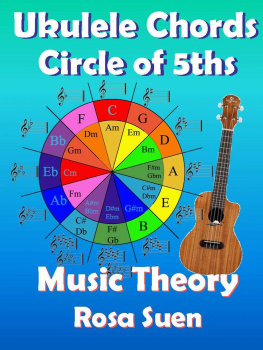
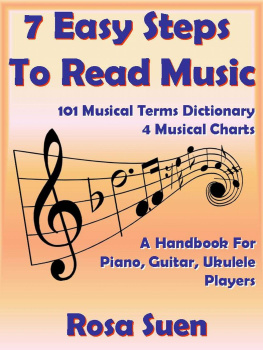
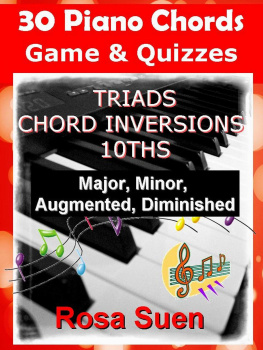
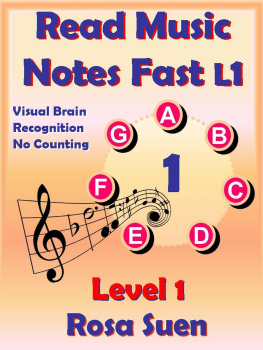
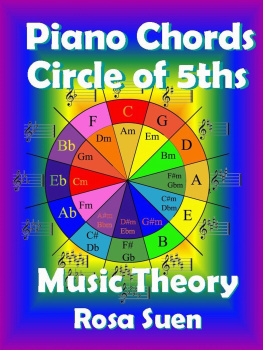
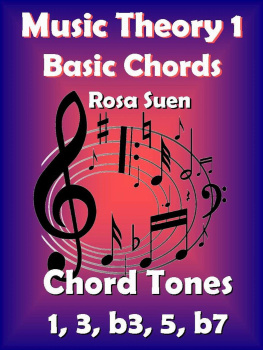
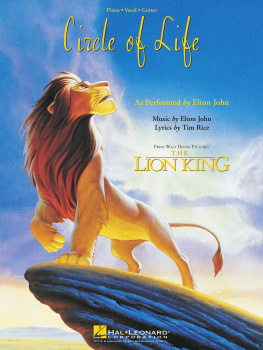
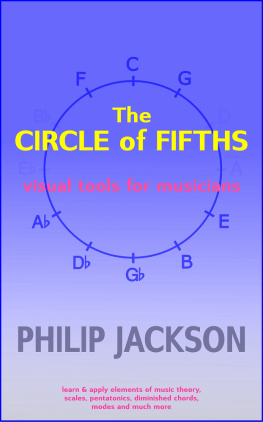

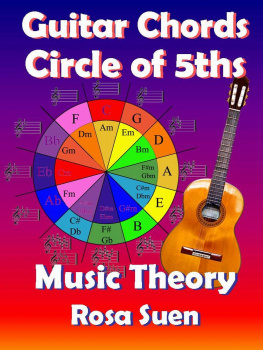


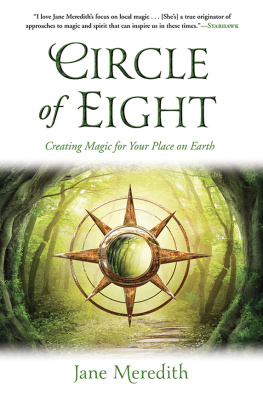
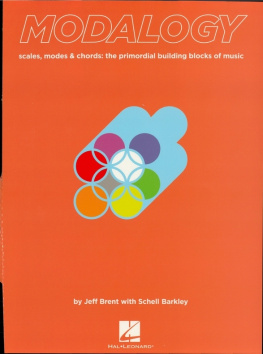

 Rosa Suen Learn Piano With Rosa Music Theory Ukulele Chords Theory Circle of 5ths Fully Explained with Application Author: Rosa Suen Cover Design: Raymond Suen E m ail: Rosa@LearnPianoWithRosa.com Copyright 2013 By Learn Piano With Rosa Studio All Rights Reserved. No part of this book may be reproduced, copied, stored, or transmitted in any form or by any means graphic, electronic, or mechanical, including photocopying, recording, or in information storage and retrieval systems without the prior written permission of Rosablanca Suen. This ebook is licensed for your personal enjoyment only. This ebook may not be re-sold or given away to other people. If you would like to share this book with another person, please purchase an additional copy for each recipient.
Rosa Suen Learn Piano With Rosa Music Theory Ukulele Chords Theory Circle of 5ths Fully Explained with Application Author: Rosa Suen Cover Design: Raymond Suen E m ail: Rosa@LearnPianoWithRosa.com Copyright 2013 By Learn Piano With Rosa Studio All Rights Reserved. No part of this book may be reproduced, copied, stored, or transmitted in any form or by any means graphic, electronic, or mechanical, including photocopying, recording, or in information storage and retrieval systems without the prior written permission of Rosablanca Suen. This ebook is licensed for your personal enjoyment only. This ebook may not be re-sold or given away to other people. If you would like to share this book with another person, please purchase an additional copy for each recipient. M y main hobby is playing piano.
M y main hobby is playing piano.  You can write to me at: Rosa@LearnPianoWithRosa.com
You can write to me at: Rosa@LearnPianoWithRosa.com F irst, we need to understand the diagram of the Circle of 5ths and how to read this Circle of 5ths. The Circle has 12 points like the face of a clock. The 12 unique tones are placed on the 12 respective points. We can take note of the following points regarding the Circle of 5ths. 1.
F irst, we need to understand the diagram of the Circle of 5ths and how to read this Circle of 5ths. The Circle has 12 points like the face of a clock. The 12 unique tones are placed on the 12 respective points. We can take note of the following points regarding the Circle of 5ths. 1.  Y ou can use the Circle of 5ths to determine key signatures. 12 Key Signatures T HE CIRCLE OF 5THS REVEALS KEY SIGNATURES
Y ou can use the Circle of 5ths to determine key signatures. 12 Key Signatures T HE CIRCLE OF 5THS REVEALS KEY SIGNATURES  H ere is a table that will allow you to visually see the order.
H ere is a table that will allow you to visually see the order.  .
.  An EZ way to memorize the Circle: Both rows spell the word BEAD. The second row is spelled with the flats.
An EZ way to memorize the Circle: Both rows spell the word BEAD. The second row is spelled with the flats.